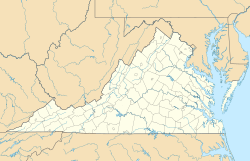| St. Paul's Episcopal Church | |
|---|---|
 Image of St. Paul's Church in Richmond, Virginia, USA | |
| Religion | |
| Affiliation | Episcopal Church |
| Ecclesiastical or organizational status | Active |
| Leadership | Rev. Charlie Dupree, Rev. Gwynn Crichton, Rev. Andie Rohrs, Rev. Rainey Dankel, and Rev. Ben Campbell |
| Year consecrated | 1845 |
| Status | Active |
| Location | |
| Location | 815 E. Grace St., Richmond, Virginia |
| State | Virginia |
 | |
| Coordinates | 37°32′24″N77°26′07″W / 37.540112°N 77.435390°W |
| Architecture | |
| Architect | Thomas Somerville Stewart |
| Style | Greek Revival |
| Completed | 1845 |
| Specifications | |
| Direction of façade | northeast |
| Capacity | 850 |
| Materials | |
St. Paul's Church | |
| Location | 815 E. Grace St., Richmond, Virginia |
| Coordinates | 37°32′23″N77°26′7″W / 37.53972°N 77.43528°W |
| Area | 0.8 acres (0.32 ha) |
| Built | 1845 |
| Architect | Steward, Thomas B. |
| Architectural style | Greek Revival |
| NRHP reference No. | 69000357 [1] |
| VLR No. | 127-0014 |
| Significant dates | |
| Added to NRHP | June 4, 1969 |
| Designated VLR | November 5, 1968 [2] |
| Website | |
| https://www.stpaulsrva.org/ | |
St. Paul's Episcopal Church is an historic Episcopal church in Richmond, Virginia, United States. Located directly across Ninth Street from the Virginia State Capitol, it has long been a popular house of worship for Richmond political figures. During the American Civil War, the church was frequently visited by Confederate President Jefferson Davis and General Robert E. Lee, earning it the nickname Cathedral of the Confederacy. [3] [4]
The church formerly displayed icons and memorials to the Confederacy, including altar cushions embroidered with Confederate flags, brass pew markers designating where Davis and Lee sat, and memorials to the Confederate first family, many of which were donated by the United Daughters of the Confederacy. [5] The church historically hosted the United Daughters of the Confederacy on Robert E. Lee Day and for the organization's annual memorial services. [5] The church began removing Confederate imagery in 2015. [5] In 2022, graffiti, including "I Can't Breathe" and the name of George Floyd, was spray-painted on the church steps during a Black Lives Matter protest. [6] The church decided to leave the graffiti intact as a "meaningful statement" and as memorials to meditate on, rather than Confederates. [6] [5]
Other notable people associated with the church are Rev. Dr. Charles Minnigerode, who led the church from 1856 to 1889, including during the Civil War and Reconstruction eras, and Rev. John Shelby Spong, who was a retired bishop of the Diocese of Newark, began to attract national attention while rector of St. Paul's (1969–1976).
St. Paul's was built in 1845 as a branch of the Monumental Church, which had outgrown its building. The Greek Revival church was designed by Thomas Somerville Stewart and modeled largely on St. Luke's Church, now Church of St. Luke & the Epiphany, in Philadelphia. [7] The cornerstone was laid on October 10, 1843 and the church was consecrated on November 11, 1845. [8] The estimated cost before construction was "not exceeding $53,500," excluding the organ and purchased lots. This cost later rose to $55,000. The organ was purchased for around $4,000 and the two lots for the church were $6,000 and $1,075. In 1845, there were 804 sittings in the nave and 358 in the gallery for a total occupancy of 1,162 parishioners.
When St. Paul's was first built, it had a much more imposing figure than it does today due to the old 225 foot tall spire. This spire was significant in that it surpassed the State Capitol as the highest structure in the city of Richmond from 1845 to 1900-1905, when the spire was removed out of stability fears. It was replaced by a much smaller 135 foot tall octagonal dome, which is how the church appears in the present day. [9] It was listed on the National Register of Historic Places in 1969 as St. Paul's Church. [1]




